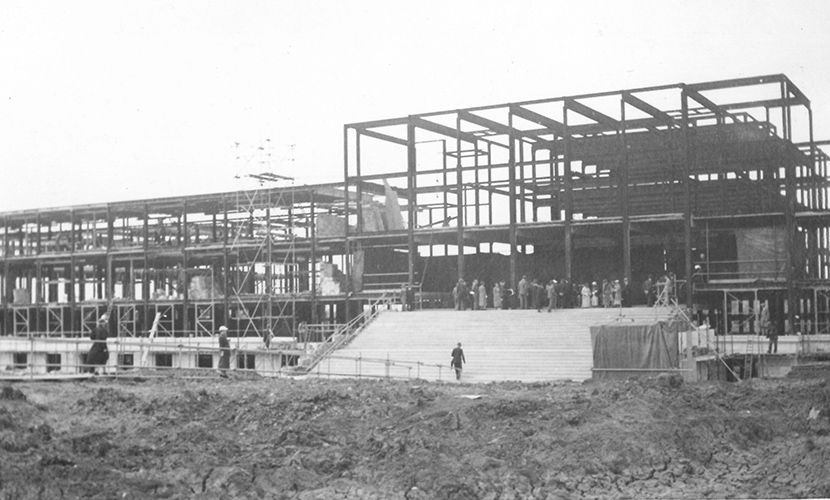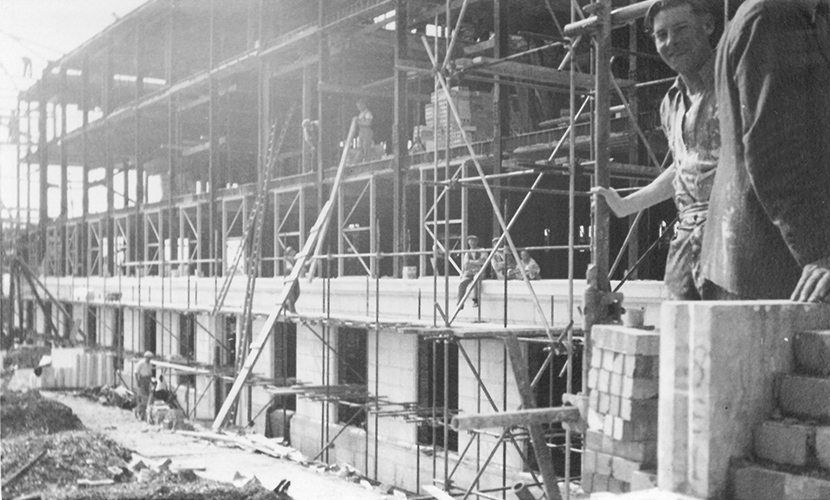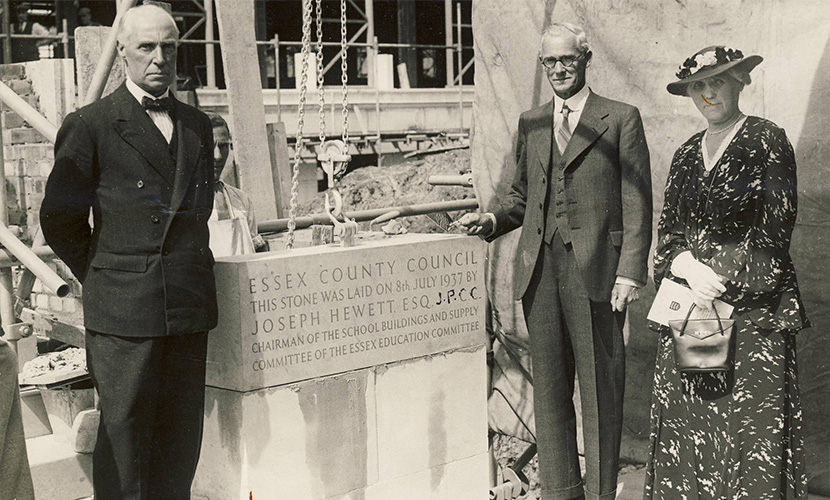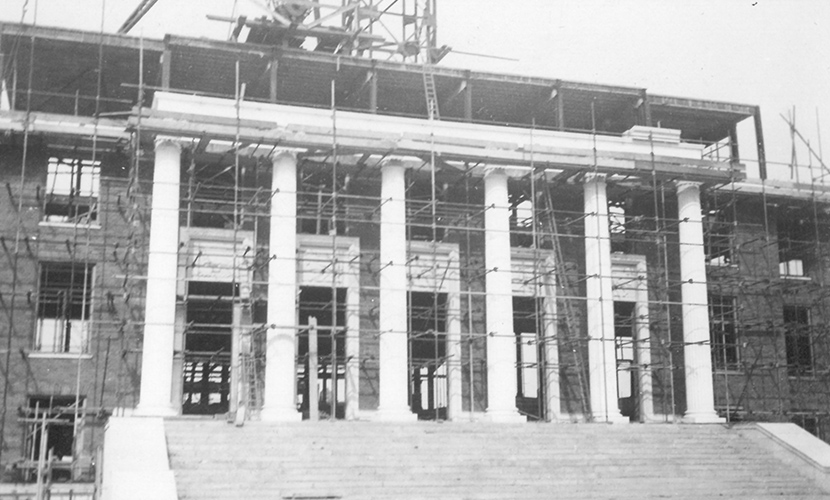‘Here, education will be more scientific than classical; more closely allied to industry. It will be a more practical type but though a different type no less inferior. It will be of equal importance and equal status. Essex from being in the backwoods, is now regarded as one of the most progressive counties.’
- Joseph Hewett, Member of the Education Committee, 1937.
Progress towards building the South-West Essex Technical College was being made. In 1934 the first architectural plans were submitted to the Education Committee.[1] The plans were drawn up by Essex County Council Architect John Stuart, F.R.I.B.A., whose previous designs included the South-East Essex Technical College[2] and the Sir George Monoux Grammar School (now Sir George Monoux Sixth Form College) which was built in the 1920s.[3] Mr Stuart reportedly worked closely with the architect of the planned Walthamstow Civic Centre so that the two new buildings would not clash.[4]
Two years later a building cost estimate of £148,150 was agreed, a significant increase on the previously anticipated cost of £120,000. A tendering process was established for the works and in April 1936 a tender of £169,007 by F. R. Hipperson & Sons was accepted and work was able to commence at the end of the year.[1]

The development of the College was, for such a large building, a quick process. Photographs of the stone-laying ceremony show the main framework of the College in place and it would be just over a year later when the College was to open.
The stone-laying ceremony took place on Thursday 8th July 1937. The audience, surrounded by metal girders and brickwork, initially gathered at the top of the steps in what is now the reception area, before moving down the main steps to view the laying of the Foundation Stone by County Councillor Joseph Hewett, J.P., Chairman of the School Buildings and Supplies Sub-committee of the Education Committee.
Attendees were from the Council, Education Committee and the schools the College was to replace, among others. Notable names included: Chairman of the County Education Committee Miss M. E. Tabor, M.A, J.P.; the Mayor of Walthamstow, G. Gibbons, J.P. (and Mayoress); the Mayor of Leyton, E. Thorn, J.P. (and Mayoress); the Bishop of Barking; Chairman of the County Council H. de Havilland, M.A., J.P.; and Chairman of the Governing Body Percy Astins.

After the ceremony Mr Astins made clear the possibility that the College may never have been built. He explained how many of those involved in establishing the College had ‘wondered whether they would ever live to see the foundation stone well and truly laid’. The statement was met with laughter from the audience; however, his sentiment was no doubt felt all too strongly by many of the people at the ceremony who had worked hard to get the College this far.[4]
Through the many decades prior to the College being built a great number of people had worked tirelessly to give technical education the attention and facilities it needed and deserved. Mr Hewett expressed this sentiment in his address:
‘[Technical education has been] the Cinderella of the education system for a long time….Cinderella is about to leave the kitchen and enter into her heritage. Our technical schools throughout the country have not been, and are not, of a nature that is at all creditable. Very often, with very few exceptions, technical schools are housed in buildings which are badly equipped and are nothing more or less than makeshift buildings’.
Mr Hewett then continued by thanking Walthamstow Council who ‘most willingly came to the country’s assistance and placed [the land the College was built on] at their disposal’.
The original stone can still be seen (as of 2023) on the right of the main steps leading up to the portico. When works were carried out to renew the steps in the 1990s the stone was re-laid by the then Principal, Mike Bourke.
After the stone-laying ceremony the College took a further fifteen months to complete. Work seems to have progressed normally during this time although the building did receive a lot of attention, not all of it positive, with some people referring to the College as the ‘white elephant’.[1]

Now the building itself was underway, the work of the Education Committee turned towards equipping the College, finding a suitable principal and populating the staff. An amount of £60,000 was provided as an estimate for the equipment required (35% of the cost of the building itself), and the equipment would in turn be provided by 112 different firms.
In October 1937, one year before the College was to open, the Committee appointed Dr Harry Lowery, M.Ed., D.Sc., Ph.D., F.Inst.P., as Principal. At that time Dr Lowery was Principal of the North West London Polytechnic and before that was a prominent figure at Manchester College of Technology. Mr W. R. Bray, lecturer and author, detailed how Dr Lowery’s main research occupation was that of a research physicist ‘so as Principal of what was to be one of the largest Technical Colleges in the country, and one which was to be largely experimental in its methods, the Committee were fortunate in being able to appoint one of the leading technical educationalists.’

Throughout 1937 and 1938 the Committee continued to work to fill the staffing positions. Many staff were brought over from the Walthamstow and Leyton Schools that the College was to replace, but the nature of teaching at the South-West Essex Technical College was to be much wider in scope and for significantly more students, meaning additional staff were to be employed.[1]
In July 1938 the previous schools and colleges closed their doors for what was considered to be the final time. Staff and students went on their summer holidays ready to return and start a new year in a brand-new building.
References
W. R. Bray, The Country Should be Grateful - The War-time History of the South-West Essex Technical College and School of Art, London: The Walthamstow Press Ltd, 1947.
Weinreb, B., et al, “The London Encyclopaedia,” 3rd ed., London, Macmillan, 2008, p. 42.
Waltham Forest College, in Fiftieth Anniversary, 1988.
The Guardian, “Yesterday’s Ceremony “Cinderella Coming into Her Own”,” The Guardian, p. 9, July 1937.
Researched and written by Thomas Barden









